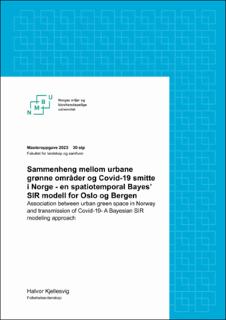| dc.contributor.advisor | Geir Aamodt | |
| dc.contributor.author | Kjellesvig, Halvor | |
| dc.date.accessioned | 2023-07-18T16:28:13Z | |
| dc.date.available | 2023-07-18T16:28:13Z | |
| dc.date.issued | 2023 | |
| dc.identifier | no.nmbu:wiseflow:6839537:54591911 | |
| dc.identifier.uri | https://hdl.handle.net/11250/3079904 | |
| dc.description.abstract | Bakgrunn: Tilgang til grønne omgivelser kan gi muligheter for fysisk aktivitet og sosial interaksjon i urbane områder i perioder med strenge retningslinjer for sosial distansering, fordi Covid-19 smitte reduseres i ventilerte områder. Formålet med denne studien er å utforske sammenhengen mellom tilgang til grønne områder og utviklingen av Covid-19 smitte på bydelsnivå i Oslo og Bergen gjennom flere bølger av pandemien.
Metode: Vi benyttet daglig publiserte antall positive PCR Covid-19 laboratorietester på bydelsnivå gjennom fire bølger av pandemien, fra 15. oktober 2020 til 15. april 2022, i Oslo og Bergen. Vi inkluderte befolkningens tilgang til grønne omgivelser i deres nærområde ved to objektive beregninger: prosentandel av grønt areal (%Ga) og gjennomsnitt mengde grønn vegetasjon Normalized Difference Vegetation Index (NDVI). Andelen av befolkningen med lavinntekt og forventet levealder ble inkludert som sosiodemografiske variabler. En Bayes’ Susceptible-Infected-Removed (SIR) modell ble benyttet for å utnytte tilgangen til de daglig oppdaterte dataene av Covid-19 smitte og samtidig ta hensyn til romlig og temporære avhengigheter i den statistiske analysen.
Resultater: Vi fant ingen signifikant forskjell i sammenhengen mellom tilgang til grønne omgivelser og Covid-19 smitte for %Ga eller NDVI. Vi fant bare signifikant sammenheng mellom tilgang til grønne omgivelser og Covid-19 smitte i den 4. bølgen i Oslo. Her ble økt tilgang til grønne omgivelser sett i sammenheng med økt smitte av Covid-19. I Oslo økte Covid-19 smitte signifikant med andelen av befolkningen med lavinntekt under bølge to og tre. I Bergen ble det ikke funnet sammenheng mellom tilgang til grønne omgivelser og Covid- 19 smitte ved noen av bølgene.
Konklusjon: Vi fant at sammenheng mellom tilgang til grønne omgivelser og Covid-19 smitte var liten sammenlignet med faktorer som sosioøkonomi og underliggende smitte. | |
| dc.description.abstract | Background: Access to green spaces can provide opportunities for physical activities and social interactions in urban areas during times with strict social distancing guidelines because Covid-19 transmission is reduced in ventilated areas. The aim of this study is to explore the association between access to urban green spaces and Covid-19 transmission at the district level in Norway’s two largest cities during several waves of the pandemic.
Methods: We used daily published numbers of confirmed laboratory PCR tests on district levels during four waves of the Covid-19 pandemic, from October 15, 2020 to April 15, 2022 in Oslo and Bergen. We included the population's access to urban green spaces using two objective measurements: percentage of green area (%Ga) and vegetation cover using the Normalized Difference Vegetation Index (NDVI). The percentages of the population with low income and average life expectancy were included as sociodemographic variables. A Bayesian Susceptible-Infected-Removed (SIR) model was used to take advantage of the daily updated data on Covid-19 incidence and account for spatial and temporal dependencies in the statistical analysis.
Results: No significant differences in the association between access to urban green spaces and Covid-19 transmission were found when we measured by %Ga or NDVI. Furthermore, access to urban green spaces was only significantly associated with Covid-19 transmission during the fourth wave of the pandemic in Oslo, where it contributed to a higher incidence rate of Covid-19. In Oslo, Covid-19 transmission increased significantly with the proportion of low-income population during waves second and third. In Bergen, no association between access to urban green spaces and Covid-19 transmission was found in any wave. Conclusions: We found that access to green space schowed minor association to Covid-19 transmission in comparison with factors such as socio-economy and the underlying transmission. | |
| dc.language | nob | |
| dc.publisher | Norwegian University of Life Sciences | |
| dc.title | Sammenheng mellom urbane grønne områder og Covid-19 smitte i Norge - en spatiotemporal Bayes’ SIR modell for Oslo og Bergen | |
| dc.type | Master thesis | |
